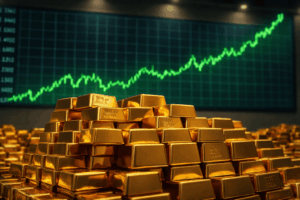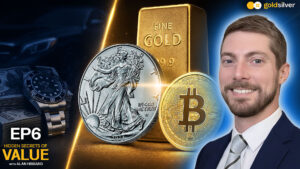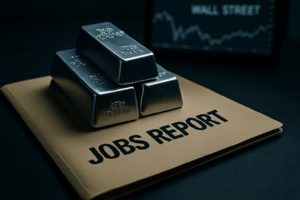Precious metals have taken center stage in global markets, with gold recently surpassing $4,100 per ounce and silver climbing above $51, marking their highest levels on record. This surge has captured investor attention worldwide, underscoring the renewed demand for tangible assets amid rising economic uncertainty. Understanding what’s fueling this gold and silver price rally is essential for investors seeking to navigate a volatile world. From Federal Reserve policy shifts to the return of inflation and the rise of central bank demand, here are the five core forces propelling gold and silver higher in 2025 — and why they matter for long-term portfolios.
1. Federal Reserve Policy Shifts and the Interest-Rate Cycle
The Federal Reserve remains the single most powerful influence on precious-metals prices. Whenever the Fed hints at easing or slows the pace of rate hikes, gold and silver historically surge. Today, with markets widely expecting another rate cut and real interest rates trending lower, the setup strongly favors metals.
Gold’s decisive break above $4,000 marks more than a milestone — it’s a signal that investors no longer trust the dollar to maintain purchasing power. Silver, too, is benefitting from this “policy premium,” having outpaced nearly every other asset class since early 2024.
The takeaway: When real yields fall and monetary confidence erodes, hard assets rise — and the Fed just handed gold and silver their next leg up.
2. Persistent Inflation and Currency Debasement
Even as headline inflation moderates, the long-term erosion of fiat currency purchasing power remains a global concern. Trillions in new debt and ongoing fiscal expansion continue to dilute the value of paper money.
Gold and silver are responding exactly as they have for centuries — acting as real-world hedges against currency debasement. Inflation doesn’t need to spiral to ignite metals; it simply needs to outpace nominal interest rates. That’s exactly the dynamic driving the current rally.
Silver’s performance, up nearly 40% year-to-date, underscores its leverage in inflationary cycles. With its smaller market size and dual industrial-monetary demand, silver often amplifies gold’s gains when inflation pressures mount.
3. Rising Geopolitical Tensions and Safe-Haven Demand
Global uncertainty remains high — from renewed trade conflicts to military flashpoints in Eastern Europe and the Pacific. Every headline reinforces the need for assets that transcend borders and counterparty risk.
Historically, gold thrives when trust in political systems wavers. The same dynamic is unfolding today: as alliances fracture and currencies wobble, investors are rushing toward safety. Silver, long considered “gold’s more volatile cousin,” tends to magnify this safe-haven bid — explaining its rapid rise past $50 for the first time since 2011.
Why this matters: In an age when geopolitics can change markets overnight, gold and silver remain the timeless hedge against the unpredictable.
4. Central-Bank Gold Buying at Multi-Decade Highs
One of the most powerful undercurrents in the gold and silver price rally is the acceleration of gold accumulation by central banks — even as prices break records. This isn’t just momentum chasing; it’s a redefinition of reserves strategy.
- Reported data through mid-2025 shows central banks adding between 20 and 22 tonnes in May and June alone.
- According to the Central Bank Gold Statistics report, the People’s Bank of China has maintained buying streaks, adding 36 tonnes in recent months, while Poland leads year-to-date net purchases with over 67 tonnes.
- The World Gold Council’s 2025 Central Bank Gold Reserves Survey reveals that 77% of responding central banks expect to increase their gold holdings over the next 12 months — a strong forward indicator of sustained demand.
This data paints a clear picture: central banks are not only absorbing a large swath of supply at current price levels, but they are also planning to continue doing so — even as gold climbs past $4,100. Their actions underpin structural support for price, not just speculative strength.
5. Silver’s Industrial Boom and Tight Supply
While gold’s rise is largely monetary, silver’s rally is powered by something even stronger: industrial necessity. The green-energy transition — spanning solar, EVs, and next-gen electronics — has turned silver into an indispensable material. Each solar panel uses roughly 20 grams of silver; with global installations soaring, demand continues to outstrip new mine supply.
Meanwhile, production growth has stagnated. Many primary silver mines are facing declining grades, and environmental regulations have constrained output. That supply squeeze, paired with relentless industrial appetite, has pushed silver to its highest level in history — over $51 per ounce — and analysts expect further upside as inventories tighten.
The takeaway: Silver isn’t just riding gold’s coattails; it’s leading the charge in the age of electrification.
Positioning for the Next Phase
The convergence of these forces — dovish central banks, sticky inflation, geopolitical instability, sovereign gold buying, and surging industrial demand — has created one of the most powerful secular tailwinds for precious metals in decades.
Gold’s breakout above $4,000 and silver’s climb past $50 aren’t speculative flukes; they’re confirmation that the world is re-pricing real assets in response to monetary and political excess.
For investors, the lesson is clear: diversify now, not later. Whether through physical bullion, storage programs, or IRA allocations, exposure to gold and silver can help preserve purchasing power and hedge against systemic risk.
Bottom line: In uncertain times, gold and silver remain the only certainties — and this rally may just be getting started.
Get Gold & Silver Insights Direct to Your Inbox
Join thousands of smart investors who receive expert analysis, market updates, and exclusive deals every week.
People Also Ask
Why are gold and silver prices rising so quickly in 2025?
Gold and silver prices have surged to record highs — over $4,100 and $51 per ounce respectively — as investors react to falling real interest rates, persistent inflation, and record central-bank gold buying. The metals are acting as safe havens amid global uncertainty and dollar weakness.
How do Federal Reserve policies affect gold and silver prices?
When the Federal Reserve cuts interest rates or signals a dovish stance, the opportunity cost of holding gold and silver drops, making them more attractive than low-yield bonds or cash. Historically, major gold rallies — including today’s — coincide with periods of negative or falling real rates.
Are central banks still buying gold in 2025?
Yes. Central banks have added over 1,000 tonnes of gold annually for three straight years, with China, Poland, and Turkey leading recent purchases. According to the World Gold Council, 77% of central banks plan to keep increasing their holdings, signaling long-term confidence in gold’s value as a reserve asset.
What role does inflation play in the gold and silver price rally?
Gold and silver hedge against inflation by preserving purchasing power as fiat currencies lose value. When inflation outpaces interest rates — as it has in recent years — investors shift from paper assets into tangible stores of value like precious metals.
Why is silver outperforming gold right now?
Silver is benefiting from both investment demand and booming industrial use. The green-energy transition — especially solar panels and electric vehicles — is creating record silver consumption, while mine supply remains constrained. This tight supply-demand balance has pushed silver past $51 per ounce for the first time in history.
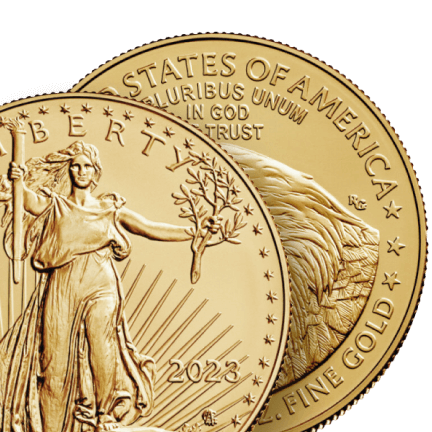
GoldSilver: Investing in Physical Metals Made Easy
GoldSilver lets you invest in real physical precious metals with flexible options to buy, sell, store, and take delivery. You’re in complete control.
Open an Account
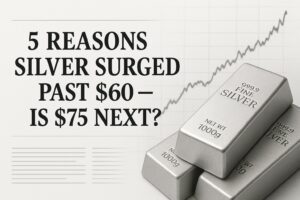
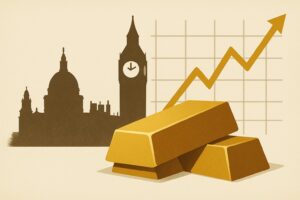
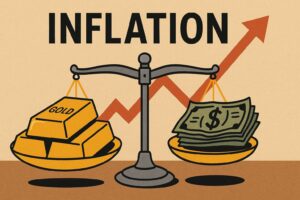
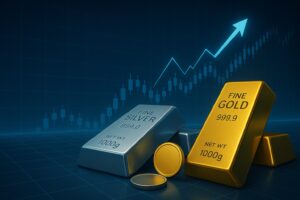
![Is Now the Best Time to Buy Silver? [Silver 2025–2030 Forecasts]](https://goldsilver.com/wp-content/uploads/2025/11/price-of-silver-300x155.jpg)
